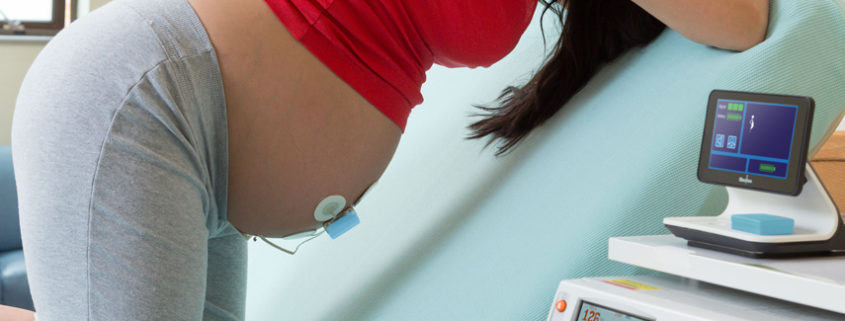Fetal Heart Rate Monitoring During Labor
What is Fetal Heart Rate Monitoring?
Fetal heart rate monitoring is a procedure used to evaluate the well-being of the fetus by assessing the rate and rhythm and the presence or absence of accelerations (increases) or decelerations (decreases) of the fetal heartbeat. It also checks how much the fetal heart rate changes around the baseline. The average fetal heart rate is between 110 and 160 beats per minute and can vary five to 25 beats per minute. The fetal heart rate may change as the fetus responds to conditions in the uterus. An abnormal fetal heart rate or pattern may mean that the fetus is not getting enough oxygen or there are other problems. An abnormal pattern also may mean that an emergency cesarean delivery is needed.
How is fetal monitoring performed? 
Using a handheld Doppler (a type of ultrasound) to listen and measure the response of the fetus’s heart rate to contractions of the uterus. This is often used during prenatal visits to count the fetal heart rate or in a pregnancy less than 24 weeks. Electronic fetal monitoring is used in late pregnancy to evaluate the fetus or to check fetal well-being during labor. It provides an ongoing record that can be read. The procedure for monitoring the fetal heart rate is painless, but internal monitoring can be uncomfortable. There are very few risks associated with this procedure, so it’s routinely done on all women in labor and delivery.
- The gel is applied to the mother’s abdomen to act as a medium for the ultrasound transducer.
- The ultrasound transducer is attached to the abdomen with straps and transmits the fetal heartbeat to a recorder. The fetal heart rate is displayed on a screen and printed onto special paper.
- During contractions, an external tocodynamometer (a monitoring device that is placed over the top of the uterus with a belt) can record the patterns of contractions.
- Sometimes, internal fetal monitoring is necessary for a more accurate reading of the fetal heart rate. Your bag of waters (amniotic fluid) must be broken and your cervix must be partially dilated to use internal monitoring. Internal fetal monitoring involves inserting an electrode through the dilated cervix and attaching the electrode to the scalp of the fetus, called a fetal scalp electrode.
There are two methods for fetal heart rate monitoring
- External fetal heart rate monitoring uses a device to listen to or record the fetal heartbeat through the mother’s abdomen. One type of monitor is a hand-held electronic Doppler ultrasound device. This method is often used during prenatal visits to count the fetal heart rate. A Doppler device may also be used to check the fetal heart rate at regular intervals during labor. Continuous electronic fetal heart monitoring may be used during labor and birth. An ultrasound transducer placed on the mother’s abdomen conducts the sounds of the fetal heart to a computer. The rate and pattern of the fetal heart are displayed on the computer screen and printed onto the special graph paper.
- Internal fetal heart rate monitoring uses an electronic transducer connected directly to the fetal scalp. A wire called an electrode is used. It is placed on the part of the fetus closest to the cervix, usually the scalp. This type of electrode is sometimes called a spiral or scalp electrode. Internal monitoring provides a more accurate and consistent transmission of the fetal heart rate than external monitoring because factors such as movement do not affect it. Uterine contractions also may be monitored with a special tube called an intrauterine pressure catheter that is inserted through the vagina into your uterus. Internal monitoring can be used only after the membranes of the amniotic sac have ruptured (after “your water breaks” or is broken). Internal monitoring may be used when external monitoring of the fetal heart rate is inadequate, or closer surveillance is needed. After internal fetal heart rate monitoring, the electrode site on the newborn baby will be examined for infection, bruising, or a laceration. The site may be cleansed with an antiseptic.
Risk:
Fetal monitoring is widely used. There are no known risks to using the fetoscope, Doppler, or external monitoring. There may be a slight risk of infection with internal monitoring. The scalp electrode may also cause a mark or small cut on the baby’s head, but this usually heals quickly. An abnormal fetal heart rate pattern does not always mean the fetus is in danger. Electronic fetal monitoring is widely used in the United States. However, studies have found that the use of electronic fetal monitoring is associated with a greater chance for vacuum and forceps use with vaginal deliveries, and for cesarean delivery.
Benefits:
Fetal monitoring may help with a possible recognition of problems in the fetus. Other testing or delivery may be necessary.
Why is fetal heart rate monitoring done during labor and delivery?
Fetal heart rate monitoring may help detect changes in the normal heart rate pattern during labor. If certain changes are detected, steps can be taken to help treat the underlying problem. Fetal heart rate monitoring also can help prevent treatments that are not needed. A normal fetal heart rate can reassure both you and your obstetrician-gynecologist (ob-gyn) or other health care professional that it is safe to continue labor if no other problems are present.
What happens if the fetal heart rate pattern is abnormal?
Abnormal fetal heart rate patterns do not always mean there is a problem. Other tests may be done to get a better idea of what is going on with your fetus.
If there is an abnormal fetal heart rate pattern, your ob-gyn or other health care professional will first try to find the cause. Steps can be taken to help the fetus get more oxygen, such as having you change position. If these procedures do not work, or if further test results suggest your fetus has a problem, your ob-gyn or other health care professional may decide to deliver right away. In this case, the delivery is more likely to be by cesarean birth or with forceps or vacuum-assisted
There is no special type of care required after external fetal heart rate monitoring. You may resume your normal diet and activity unless your health care provider advises you differently.
Your health care provider may give you additional or alternate instructions after the procedure, depending on your particular situation.




Leave a Reply
Want to join the discussion?Feel free to contribute!